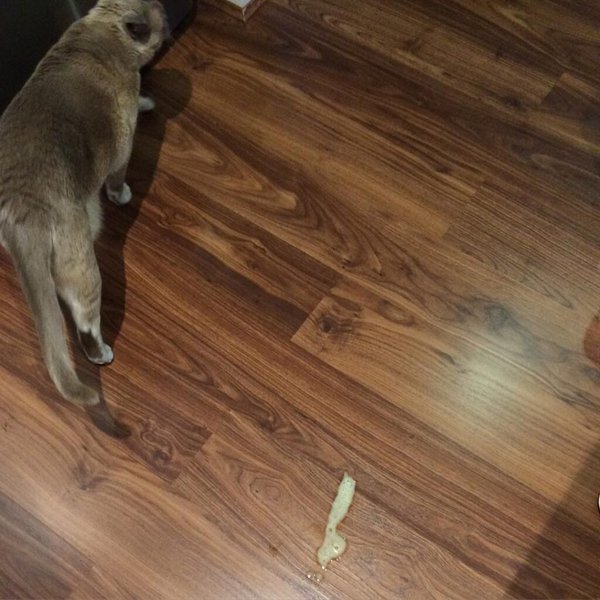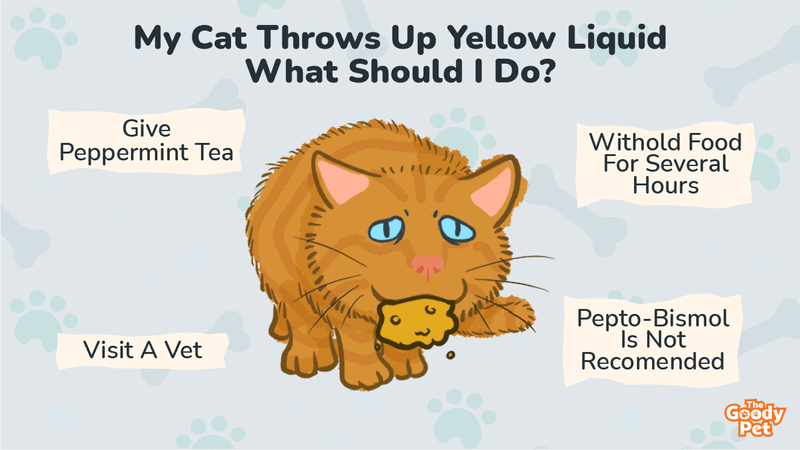Your cat vomiting once or twice within a couple of months is no cause for concern. However, if your feline buddy starts vomiting frequently, this is not a good sign, especially if they are throwing up yellow liquid.
Why do cats throw up yellow liquid? Yellow color in your cat’s vomit shows that your cat is vomiting bile. Very often, vomiting bile is a sign of underlying gastrointestinal, pancreatic, and hepatic health issues, and it’s advisable to see a vet immediately for the problem to be diagnosed and treated.
If you’re worried because your cat is throwing up yellow liquid, this article will answer all your questions about your cat’s condition. We will look at what throwing up yellow liquid means for your cat, whether it is normal for cats to vomit every day, reasons why your cat is vomiting, and so on. To start off, let’s look at what you need to do when your cat throws up yellow bile.
What Should I Do If My Cat Throws Up Yellow Bile?
How Is Bilious Vomiting Syndrome Treated In Cats?
Usually, your cat will stop vomiting yellow bile on its own. If the vomiting continues for several days, however, this is a sign of a serious underlying condition, in which case you need to see a vet immediately.
Treatment for bilious vomiting syndrome will depend on the underlying cause diagnosed by the vet. If your cat is vomiting bile because of food-related causes, the vet will recommend special foods for cats with stomach sensitivities.
You will also be advised to give your feline buddy small amounts of food multiple times during the day. Your cat should never go for long hours without food when they are throwing up yellow bile.
If the vomiting is not food-related, the vet will give prescription drugs depending on the underlying condition.

How Can I Treat My Cat For Vomiting At Home?
The first thing you need to do if your cat is vomiting is to withhold food. Vomiting is a sign of an irritated stomach, and giving more food will irritate the stomach further. Withhold food for several hours as you observe the cat. If you notice that vomiting has stopped, give some drinking water.
If your cat doesn’t vomit even after taking water, you can then feed them with small amounts of bland food. Freshly boiled chicken is a great option. Avoid anything that contains oil or spices.
Another way to settle a cat’s upset stomach is to give peppermint tea, which is known for its ability to ease stomach upsets.
Can I Give My Cat Pepto-Bismol For Throwing Up?
While Pepto-Bismol can be used to settle a cat’s upset stomach, we do not recommend it. Pepto-Bismol contains aspirin, which is toxic to cats in excessive doses. Pepto-Bismol should only be given to cats as a last resort, and in very small doses.
What Does It Mean If My Cat Throws Up Yellow Liquid?
Throwing up yellow liquid, which is also known as bilious vomiting syndrome in cats, shows that there is bile in your cat’s vomit.
Bile is a yellow or green colored liquid that is produced in the liver and stored in the gallbladder. Bile is produced to help with digestion in the duodenum.
Sometimes, when bile is secreted into the duodenum, instead of moving along the small intestines, reverse motility in the small intestines can cause the bile to flow back into the stomach. Backflow of bile into the stomach causes irritation and inflammation, which in turn causes your cat to vomit in order to expel the bile from the stomach.
What Causes Bilious Vomiting In Cats?
Very often, bilious vomiting in cats happens due to an empty stomach.
When your cat’s stomach is empty, any bile that flows back into the stomach will land on empty stomach lining, thus increasing the likelihood of inflammation and irritation. This is why frequent feeding often helps stop bilious vomiting.
However, if your cat keeps throwing up yellow liquid, there could be a deeper problem. Some other conditions that could cause your cat to keep throwing up bile and not eating include gastritis, liver disease, renal insufficiency, intestinal parasites, hyperthyroidism, pancreatitis, indigestion and constipation, inflammation of the liver or gallbladder, and gastrointestinal obstruction.
Your cat throwing up stomach acid can also be caused by ingesting something that your cat’s stomach is intolerant to, ingestion of toxins, kidney disease, diabetes, hepatic insufficiency, various types of cancer, or irritable bowel syndrome.
It is impossible to know the actual problem causing bilious vomiting syndrome in cats without a proper diagnosis, which is why you should always take your furry buddy to the vet whenever you notice them vomiting yellow liquid. Ignoring the condition may have huge consequences for your cat.
Is It Normal For A Cat To Throw Up Every Day?
It is totally normal for your cat to vomit occasionally. This usually happens because your cat has eaten something that’s not good for them. The vomiting should quickly stop once the substance has been expelled from your cat’s body.
However, if the vomiting is happening frequently, there is nothing normal about this, so you need to seek medical attention for your feline buddy. So, when should you be concerned about your cat vomiting? How do you know when the vomiting frequency is beyond normal?
Generally, when your cat vomits more than once in a day over a period of 2 to 3 days, this is not a good sign.
You need to have your cat checked out by the vet. In the same vein, if your cat is vomiting multiple times within a week, you also need to see a vet.
Other Causes For Concern
You should also take your cat to the vet for vomiting if the vomiting is accompanied by other symptoms like abdominal pain, loss of appetite, and blood in your cat’s vomit.
Other signs that you should also watch out for include lethargy, diarrhea, bloody stool, unusual behavior, increased frequency of urination, changes in grooming behavior, and hiding.
What Information Should You Provide At The Vet’s?
Since your feline buddy cannot speak for themselves, the information you provide at the vet’s will be very useful in coming up with the right diagnosis.
Some of the information that your vet will want to find out include how your cat’s vomit looked like (smell, color, any unusual objects in the vomit), the date when your cat started vomiting, vomiting frequency, other symptoms like diarrhea or lethargy, and so on.
You’ll also need to give information about any recent changes that can be stressful for your cat, including environmental and dietary changes.
How Do I Know If My Cat’s Stomach Hurts?
Since wild cats were solo predators, they learned to hide their pain as much as possible, because showing pain and weakness in the wild could invite attacks from other predators.
While cats have been domesticated for hundreds of years now, they still retain the instinct to hide their pain. This means you’ll have a hard time knowing when your cat is in pain from a stomach upset. That said, there are some signs that can tell you that your cat’s stomach hurts.
Some of these signs include vomiting, a hunched over posture as the cat attempts to relieve the pain, a swollen abdomen that is tender to the touch, difficulty passing urine, loss of appetite, diarrhea, blood in stool, licking of the lips (this is a sign of nausea), and weight loss.
In extreme cases, your cat will cry or whimper due to pain from a stomach upset.
How Long Does An Upset Stomach Last In Cats?
In most cases, stomach upsets in cats will pass within 24 to 48 hours, even without treatment. All you need to do is to reduce food intake and keep your four-legged buddy hydrated.
If the symptoms of a stomach upset last for more than 48 hours, it’s time to call the vet and have your cat checked out.
How Do You Comfort A Sick Cat?
If your cat has a stomach upset, the first thing you need to do is to give the right kind of food. When your cat has a stomach upset, they will have a hard time digesting normal food, so you should give them maintenance food that is specially formulated to soothe stomach upsets.
In addition, you should ensure that your cat is getting enough drinking water. Vomiting and diarrhea can quickly lead to dehydration, so it is very important to keep your cat hydrated.
Related Questions
Should I Feed My Cat After He Throws Up? No. If your cat throws up, wait a few hours before trying to feed them again. This will give enough time for any irritation in your cat’s stomach to ease up. After that, give your cat bland foods, such as boiled chicken in small amounts. If they keep this down, give some more food after one or two hours.
What Does The Color Of Cat Vomit Mean? The color of your vomit can help you determine the reason behind your cat’s vomiting. For instance, if your cat is vomiting yellow vomit, this means that there is bile in your cat’s vomit. White, foamy vomit, on the other hand, means that your cat is vomiting stomach acids.
Is There An Anti-Nausea Medicine For Cats? Yes, there are anti-nausea medicines for cats, such as maropitant citrate (Cerenia). Maropitant citrate is approved by the FDA for use in treating nausea and vomiting in cats and dogs too. Other anti-nausea medicines for cats include metoclopramide (Octamide, Maxolon and Reglan), and mirtazapine (Remeron).





